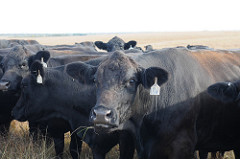Released: Nov. 2, 2016
Feeding cull cows prior to sale may add value
K-State specialist gives tips aimed at boosting ranch revenues.

MANHATTAN, Kan. – Every year beef cattle producers have to make decisions about how to handle open cows that didn’t become pregnant. Most producers simply sell the animals after pregnancy check time. However, it’s possible that with a little more investment, they can provide more revenue to their operation, according to Kansas State University professor Chris Reinhardt.
Cull females make up around 20 percent of ranch revenues, he said. Through proper marketing, it is possible to add value before selling the animals.
“There are two different types of cull females,” said Reinhardt, who is a beef specialist with K-State Research and Extension. The first is an older cow that has been a productive cow in the past, but for whatever reason, did not become pregnant this year. It’s possible she’s missing teeth so she cannot process the nutrients available and was thin at breeding time.
On a price-per-pound basis, a thin cow will bring in less revenue than a heavier, fatter cow will, but there is an opportunity to add value to the thin cow.
“Given the amount of rain this year, the amount of grain available, the price of feed and possibly standing pasture on which you could supplement, producers have the opportunity to add pounds to thin cows. If a cow is old and thin there is an opportunity to add weight and actually increase her weight as well as the price per pound you receive by feeding her for a period of time.”
Producers, however, should be mindful of the law of diminishing returns. If a cow is thin there is probably a reason, such as poor teeth. If that’s the case, high quality silage, grain, protein supplements, hay and pasture can help add condition to the cow. While she may not gain weight as she did in the past, the use of high quality feeds can help. This typically takes six to eight weeks.
“Our goal is to put on weight, body condition, muscle, and fat, and get them to market,” Reinhardt said. “The length of time the cow is on feed will be driven by how thin she is and the cause of her loss of condition. If it is a matter of old or missing teeth and we can feed her grain, corn silage, or distiller’s grains, the goal is to move her body condition score to a five, in which she has full expression of muscle and a slight but not excessive cover of fat over the ribs, brisket, and round. Anything beyond a body condition score of five, where we begin to see overall smoothness and pockets of fat, and she rapidly becomes inefficient.”
Reinhardt referred to a body condition scoring method for beef cows, which describes an animal’s relative fatness on a nine-point scale. A body condition score of five (BCS 5) is average. A score of one would be extremely thin. Nine is extremely fat.
The goal is to feed the cow to a BCS of five or five and a half, he said. This raises the cow to a different carcass value grade, which boosts what the buyer will pay per pound.
Reinhardt encourages Kansas producers to work with local K-State Research and Extension staff to develop a program for each female.
Feeding to sell as bred cattle
“If a producer has a fairly young cow that for whatever reason didn’t settle during the breeding season they could feed her to rebreed and sell,” Reinhardt said. “This is a unique year as we are going to have inexpensive grain and a lot of ranchers have abundant hay. Some cattle producers in the south still have really good grass. This presents an opportunity to turn her from an open female in the fall in a marketplace flooded with open females to a fall calving cow for next calving season.”
“There are plenty of fall calving operations who are looking to bolster their numbers and bring in bred females as opposed to carrying over an open female throughout the season waiting for the next breeding season,” Reinhardt said. “There is an opportunity to add price per pound to her as a useful, reproductive female.”
As fertility tracks in a linear fashion, Reinhardt recommended producers improve the body condition score of open cows. He also recommended having a veterinarian ensure that such cows do not have health issues that could be preventing them from conceiving.
“Producers do not have to be nearly as aggressive in feeding these females if they are looking at an early winter or mid-winter breeding time,” Reinhardt said. “Good quality feedstuffs must be available to meet the nutrient requirements for that open female as she should put on a little weight.”
-30-
K-State Research and Extension is a short name for the Kansas State University Agricultural Experiment Station and Cooperative Extension Service, a program designed to generate and distribute useful knowledge for the well-being of Kansans. Supported by county, state, federal and private funds, the program has county Extension offices, experiment fields, area Extension offices and regional research centers statewide. Its headquarters is on the K-State campus, Manhattan.
Story by:
Connor Orrock
K-State Research and Extension
cworrock@ksu.edu
For more information:
Christopher Reinhardt, cdr3@k-state.edu or 785-532-1672
